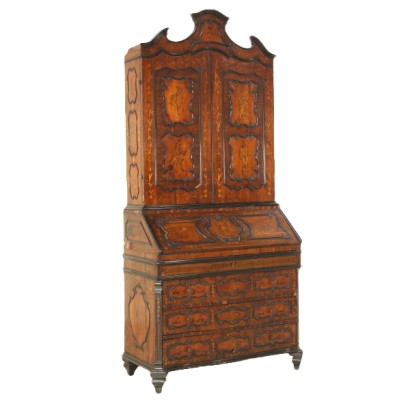The fore Lift
Features
Style: Barocchetto (1720-1770)
Age: 18th Century / 1701 - 1800
Origin: Lombardia, Italy
Main essence: Walnut
Material: Solid Maple , Bronze , Solid Cherry , Walnut Veneer
Description
Mobile the two bodies. On the basis of a chest of drawers slightly move with four drawers one of which is thin placed under the leaf to the fore; the lift is composed of two wings shaped in the upper part to follow the movement of the cornice in architecture. The furniture veneered in walnut has the classic frames ebanizzate that contain reserves in cherry in which they are inserted to inlay the masks of the commedia of the art, finely etched. In the flanks, alternating inlays of musical instruments to the figures of Harlequin, Pulcinella and Brighella; in the drawers in the reserves side have inlays landscape, the central repeat a seated figure. The four masks that fill the panels of the doors of the lift, among which we recognise the Trousers, the Captain, Milanese and Balanzone. The central space of the lift system is dedicated to the female figure of the Dove, in two reserves in the side, there are two baskets of flowers. The inside of the tilting door has a scarabattolo with 10 small drawers and secret inlaid with architectural motifs. All of the mobile also features floral inlays on the entire surface, while in the cornice are inlaid with a bird. Interior spruce, and knobs in bronze.
Product Condition:
The mobile has never been changed and is in the first patina.
Dimensions (cm):
Height: 241
Width: 107
Depth: 54
Additional Information
Notes historical bibliographic
This, to be placed in the last quarter of the 18th century. due to the presence of two flower baskets already neo-classical style, is of undoubted Lombard production for shape, construction, the use of wood and frames ebonized frames. It does have characteristics that suggest a Piedmontese influence, especially in parts inlaid particularly cured in the engraving, marquetry floral in taste to fill the posts and crossbar but also in the reserves in black picture frames, in the shape resemble the patterns of Web panels. The inlay of the scarabattolo presents strong analogies with a Piedmontese furniture production that the scholar Roberto Antonetto ¹ analyzes and combines in its height. among these items is the practice of recovering inlaid décor of Augsburg, sometimes parts of the cabinets, sometimes the only marquetry coating, to use it to serve Piedmontese furniture. Even in our mobile scarabattolo it looks like done with the recovery of some Cabinet probably oldest inlays of Augsburg. If then is a boundary between Lombardy and Piemonte or Piedmont a cabinetmaker who moved to Lombardy we can not know. Unusual but full eighteenth is a tribute to the commedia dell'arte in inlay outside of the housing. ¹ Antonetto Roberto, the 18th-century Piedmontese mobile 2010, 2 vols. ed. Allemandi, see pages 94-97 vol. IIStyle: Barocchetto (1720-1770)
With this term we designate, for what specifically relates to furniture, a part of the production carried out in Italy in the period of time between the Rococo era and the first phase of neoclassicism.It is characterized by the formal and decorative structure still rigidly adhering to the dictates dear to the Baroque period (hence the term baroque) and to the Louis XIV fashions and yet the new times are captured in the adoption of smaller volumes, more decorative modules. elegant, often directly inspired by French fashion, but always executed with rigorous principles of ornamental symmetry.
The tendency to assimilate formal and volumetric novelties but not to incorporate their ornamental elaboration finds natural explanation in Italy in the fact that in this century the great aristocracy experienced an unstoppable political and economic decline.
If in the previous century there was a great profusion of furnishings destined to adorn newly built homes, to proudly show the power of the client family, in the eighteenth century they rather take care to update the building with only the furniture strictly necessary for the new needs imposed by fashion or functional needs.
The old scenographic apparatus is maintained and the new must not contrast too much.
Find out more about the Barocchetto with our insights:
Classic Monday: discovering Barocchetto
Classic Monday: between Baroque and Barocchetto
Classic Monday elegant and unusual with two Barocchetto balustrades
FineArt: Pair of Barocchetto chairs, Venice
Emilian canterano first quarter XVIII century, first Barocchetto
Ribalta a urn, Milan mid-18th
































